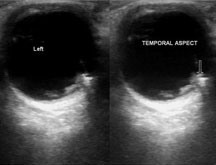
Intraocular foreign body removal is a surgical procedure performed to remove foreign objects that have entered the interior of the eye. Injuries involving intraocular foreign bodies can occur as a result of accidents, trauma, or occupational hazards. The presence of a foreign body in the eye can cause damage to ocular structures, inflammation, and potential vision-threatening complications. Here are key points about intraocular foreign body removal:
Indications:
- Intraocular foreign body removal is indicated when a foreign object has penetrated the eye and is located within the vitreous cavity, retina, or other intraocular structures.
Common Foreign Bodies:
- Foreign bodies can include metal fragments, glass, wood, or other materials that have entered the eye.
- The nature and composition of the foreign body may influence the surgical approach and techniques used for removal.
Diagnostic Imaging:
- Imaging studies, such as X-rays or computed tomography (CT), may be used to identify and localize the intraocular foreign body.
- Ophthalmic examination and imaging help assess the extent of ocular damage and plan the surgical intervention.
Surgical Techniques:
- The surgical procedure is typically performed in an operating room under sterile conditions.
- Microsurgical instruments, including intraocular forceps and vitrectomy tools, may be used to carefully remove the foreign body.
Vitrectomy:
- In some cases, vitrectomy may be performed in conjunction with foreign body removal.
- Vitrectomy involves the removal of the vitreous gel and may be necessary to access and remove the foreign object.
Intraocular Reconstruction:
- Depending on the extent of damage caused by the foreign body, additional procedures may be performed to repair or reconstruct intraocular structures.
Postoperative Care:
- After surgery, patients are closely monitored for complications such as infection, inflammation, or changes in intraocular pressure.
- Medications, including antibiotics and anti-inflammatory drugs, may be prescribed to aid in healing and prevent infection.
Visual Rehabilitation:
- Visual recovery after intraocular foreign body removal depends on factors such as the location and size of the foreign body, as well as the extent of ocular damage.
- Rehabilitation may involve additional treatments, such as laser therapy or further surgical procedures, to address complications and optimize visual outcomes.
Complications:
- Complications associated with intraocular foreign body removal can include infection, retinal detachment, and changes in vision.
- Early detection and prompt intervention are crucial for minimizing complications.
Intraocular foreign body removal is a complex and delicate procedure that requires the expertise of an ophthalmic surgeon, often a vitreoretinal specialist. The goal is to safely and completely remove the foreign body, address any ocular damage, and optimize visual outcomes. If you or someone you know has experienced an ocular injury involving a foreign body, seeking immediate medical attention is essential for a thorough evaluation and appropriate management.